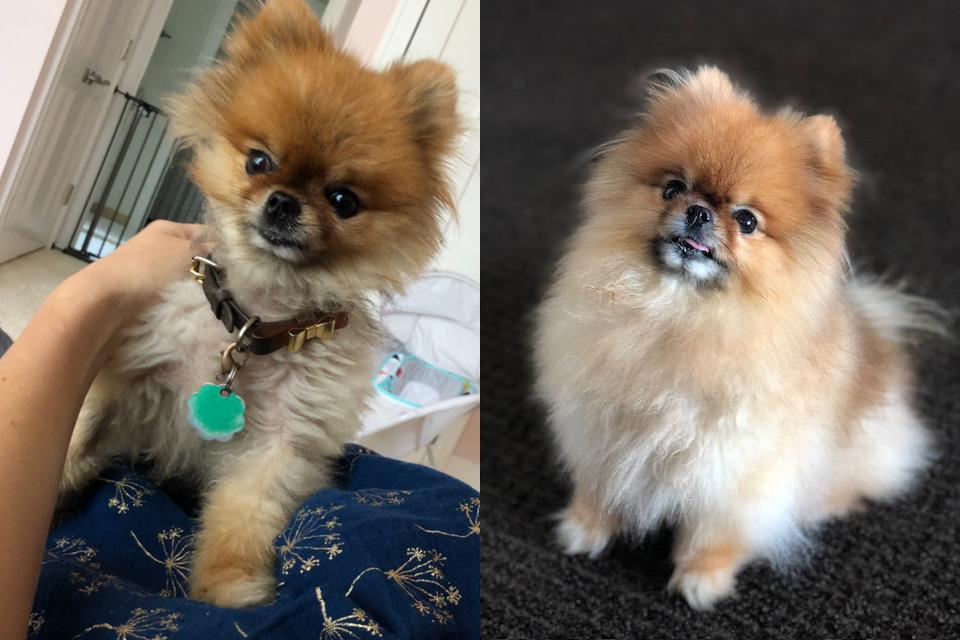
By Dr. Jennifer Schissler
Pomeranians are perky and precious puffballs! Those enamored with the breed know that some are mysteriously plagued with hair loss on their body and tail. The once lush, soft, and luxurious coat becomes coarse and sparse over a period of months to years. The skin can also darken and become scaly. The condition is referred to as “Black Skin Disease” by owners and breeders, and “Alopecia X” by veterinarians. Pet parents are understandably concerned about the possibility of underlying illness, and winter cold intolerance. Sadly, they also feel judged, as members of the public associate baldness in dogs with neglect and contagion.
What is Alopecia X?
Although visually dramatic, the good news is that this condition is cosmetic only, and treatment is not medically necessary.
Alopecia X most commonly occurs in plush-coated breeds including Pomeranians, Alaskan Malamutes, Keeshonds, and Chow-Chows. The hair follicles on the body and tail quit actively growing and get stuck in a resting phase. Then, when the hair is naturally shed, it is no longer replaced. The cause of this hair cycle arrest is unknown and may be variable, hence the name “Alopecia X.” This condition was originally thought to have a hormone basis because it responds to supplementation with the hormone melatonin. It is also known to variably respond other drugs that can reduce hormones secreted by the adrenal gland. Sexually intact individuals may respond to a spay/neuter procedure.
Unfortunately no one medication has been reliably successful, and some treatments that affect adrenal gland hormones are not recommended due to potential side effects.
How is Alopecia X diagnosed?
Alopecia X is diagnosed by ruling out other causes of alopecia. A physical exam, thorough history, and blood tests are often performed by a veterinarian to assess for other hormonal causes of alopecia, including hypothyroidism and hyperadrenocorticism. The veterinarian may also perform skin scrapings and microscopic examination of samples from the skin to look for infection and mites. Sometimes a skin biopsy is performed to help solidify the diagnosis.
What is microneedling?
Microneedling is a new procedure. At present, there are very few veterinary dermatologists performing this procedure worldwide.
This technique produces temporary skin microtrauma with a derma-roller instrument, which stimulates the hair follicles to come out of the resting phase and start actively producing hairs again. Because Alopecia X is a cosmetic disease, microneedling is only justifiable given its low risk of side effects and high likelihood of success, and requires proper technique, thorough disinfection of the skin, sterile instrumentation, anesthesia, and multimodal pain control. Therefore, this procedure should be performed by a veterinarian trained in this technique. Dr. Jennifer Schissler, dermatologist at the James L. Voss Veterinary Teaching hospital, offers microneedling to patients who have failed oral melatonin supplementation and for which anesthesia is considered low risk.
What are the results?
Expectations are that patients will rest comfortably after the procedure and be back to their normal energy level and appetite within 24 hours after the procedure. Hair regrowth occurs in the majority of patients slowly within weeks to months, but it is not guaranteed.

Thus far, patients have had noticeable regrowth within six months or fewer. Final results in terms of coat density in some patients are still pending, as complete regrowth can take up to 18 months. One patient received microneedling over two years ago and maintains a full coat. Whether or not patients will require repeat treatment many years in the future is unknown. Some dermatologists have found that a second procedure is required to fill in gaps in the coat regrowth.
Why isn’t this treatment used for pattern baldness in people?
Put down that derma-roller! In pattern baldness, the hair follicle becomes small due to hormones and genetics. Because the follicles are small and make tiny hairs or no hairs at all, stimulating the hair with microtrauma is not expected to restore the hair on one’s head.
What should I do if I have a bald dog?
Consult with your veterinarian to identify the cause of the baldness.
If you are concerned that your dog may have Alopecia X, ask your veterinarian about a referral to the CSU Dermatology and Otology service for diagnosis and a microneedling treatment consultation.
Dr. Jennifer Schissler is a board-certified veterinarian with the Dermatology and Otology service at Colorado State University’s James L. Voss Veterinary Teaching Hospital. Make an appointment or email the dermatology service, (970) 297-5000, derm@colostate.edu.